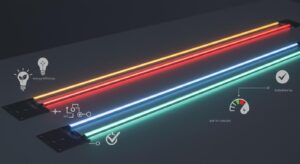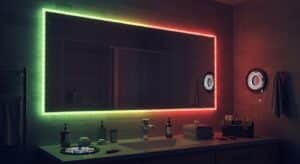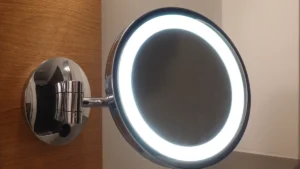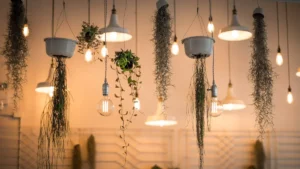
When it comes to LED displays, the choice between edge-lit and backlit designs can significantly impact your experience. Edge-lit LED lights stand out for their slim and lightweight structure, making them perfect for sleek devices like laptops or tablets. On the other hand, backlit LED lights excel in delivering superior image quality. They provide deeper blacks, higher contrast, and more uniform brightness. If you prioritize energy efficiency, backlit options also outperform edge-lit ones by reducing light loss and maximizing output. Your decision ultimately depends on whether you value design, performance, or efficiency.
Key Takeaways
Choose edge-lit LED lights for a sleek, lightweight design that is perfect for portable devices like laptops and tablets.
Opt for backlit LED lights if superior image quality, deeper blacks, and higher contrast are your top priorities, especially for tasks like graphic design or video editing.
Consider energy efficiency: edge-lit displays consume less power due to fewer LEDs, making them a more eco-friendly choice.
Backlit LED lights offer local dimming capabilities, enhancing contrast and providing a more immersive viewing experience, particularly in dark scenes.
Evaluate your budget: edge-lit LED lights are generally more affordable, while backlit options may require a higher initial investment but deliver better performance.
For personal use, edge-lit displays are ideal for casual viewing, while backlit displays are better for gaming and movie-watching.
In business settings, backlit LED lights are recommended for their superior brightness and clarity, ensuring effective presentations and digital signage.
Understanding Edge-lit and Backlit LED Lights
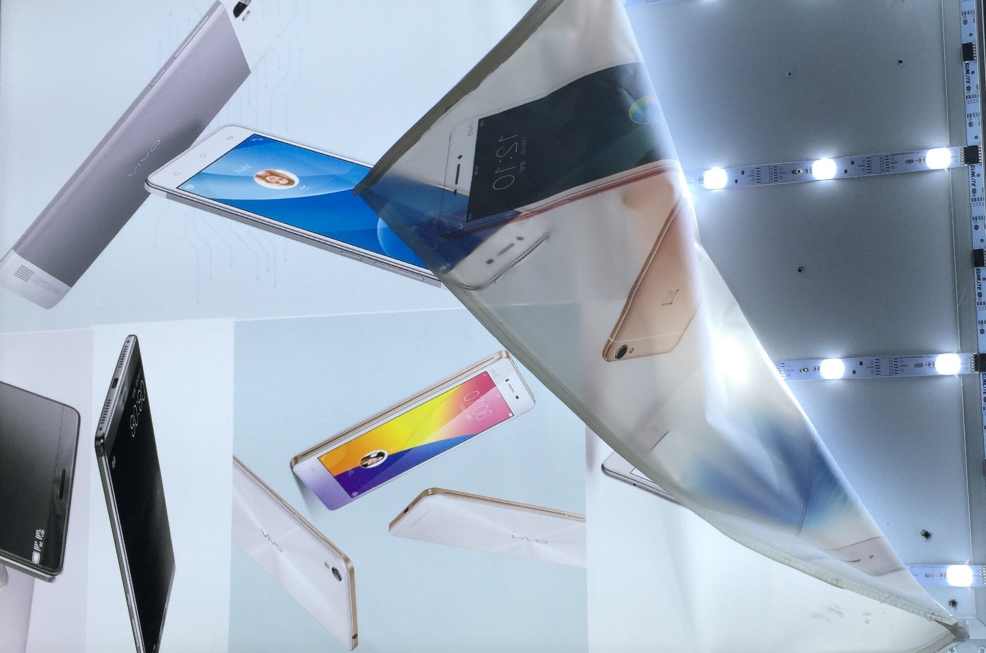
What Are Edge-lit LED Lights?
Edge-lit LED lights use a unique design where LEDs are positioned along the edges of the display panel. This arrangement allows light to travel horizontally through a light-guide plate, which then disperses it evenly across the screen. The result is a thinner and lighter display, making edge-lit technology ideal for devices like laptops, tablets, and smartphones.
One of the standout features of edge-lit displays is their slim profile. By placing LEDs at the edges, manufacturers can reduce the overall thickness of the screen. This makes edge-lit displays perfect for applications where space-saving designs are essential. Additionally, these displays often incorporate high-efficiency materials, such as PMMA light guide plates and nano-grade diffusers, to ensure smooth and soft light output.
However, edge-lit LED lights may struggle to achieve the same brightness levels as other technologies. The placement of LEDs around the perimeter limits the surface area they can illuminate directly. This can result in less uniform brightness, especially in larger screens. Despite this, edge-lit displays remain a popular choice for those prioritizing sleek aesthetics and lightweight designs.
What Are Backlit LED Lights?
Backlit LED lights take a different approach by positioning LEDs directly behind the display panel. This setup ensures that light is evenly distributed across the entire screen, resulting in superior brightness and image quality. Backlit displays excel in delivering deeper blacks, higher contrast, and more accurate colors, making them a preferred choice for tasks requiring precision, such as graphic design, photography, and video editing.
One of the key advantages of backlit LED lights is their ability to utilize local dimming zones. These zones allow specific areas of the screen to dim or turn off entirely, enhancing contrast and creating richer visuals. This feature is particularly beneficial for viewing content with dark scenes, as it provides a more immersive experience.
Backlit LED panels also tend to be more energy-efficient compared to edge-lit options. The light produced by the LEDs travels directly through the diffuser material, minimizing light loss and maximizing output. While backlit displays are generally thicker than edge-lit ones, their performance benefits often outweigh the added bulk. For users seeking exceptional image quality and brightness, backlit LED lights are an excellent choice.
Key Differences Between Edge-lit and Backlit LED Lights
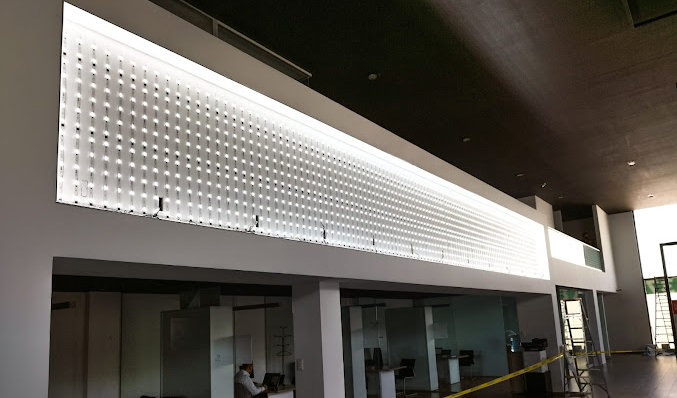
Thickness and Design
When it comes to thickness and design, edge-lit LED lights take the lead. The placement of LEDs along the edges of the display allows manufacturers to create thinner and sleeker panels. This design makes edge-lit displays ideal for modern devices where a slim profile is essential. You’ll often find these in ultra-thin TVs, laptops, and smartphones. Their lightweight structure also makes them easier to mount or transport.
In contrast, backlit LED lights require LEDs to be positioned directly behind the screen. This arrangement increases the overall thickness of the display. While backlit panels may not offer the same slim design as edge-lit ones, they prioritize functionality over form. If you value aesthetics and portability, edge-lit displays are the better choice. However, if performance matters more, the added bulk of backlit displays becomes a worthwhile trade-off.
Brightness and Image Quality
Backlit LED lights excel in brightness and image quality. The LEDs positioned behind the screen provide uniform backlighting, ensuring consistent brightness across the entire display. This setup enhances contrast ratios and delivers deeper blacks, making backlit displays perfect for tasks requiring high visual precision, such as photo editing or watching movies with dark scenes. You’ll notice that backlit displays produce more vibrant and lifelike images compared to their edge-lit counterparts.
Edge-lit LED lights, on the other hand, may struggle to achieve the same level of brightness. The light from the LEDs must travel through a light-guide plate, which can result in uneven brightness, especially on larger screens. While edge-lit displays still offer decent image quality, they fall short when compared to the superior performance of backlit LED lights. If you prioritize vivid visuals and consistent brightness, backlit technology is the clear winner.
Local Dimming Capabilities
Local dimming is another area where backlit LED lights shine. This feature allows specific sections of the screen to dim or turn off entirely, enhancing contrast and creating a more immersive viewing experience. For example, when watching a movie with dark scenes, backlit displays can produce deeper blacks by dimming the LEDs in those areas. This capability significantly improves the overall picture quality.
Edge-lit LED lights, however, have limited local dimming capabilities. Since the LEDs are located only along the edges, controlling specific zones of the screen becomes challenging. As a result, edge-lit displays may struggle to achieve the same level of contrast and depth as backlit displays. If you’re looking for a display with advanced dimming features, backlit LED lights are the better option.
Energy Efficiency
When it comes to energy efficiency, edge-lit LED lights often outperform their backlit counterparts. The design of edge-lit displays places LEDs along the edges of the screen, which reduces the number of LEDs required. This setup minimizes energy consumption, making edge-lit displays a more eco-friendly option. If you prioritize lower electricity bills or aim to reduce your carbon footprint, edge-lit technology is a practical choice.
Backlit LED lights, on the other hand, consume more energy due to their design. The LEDs positioned directly behind the screen provide uniform backlighting, but this requires more power to achieve the superior brightness and image quality they are known for. While backlit displays deliver exceptional visuals, their higher energy usage may not align with your goals if energy efficiency is a top priority.
Pros and Cons of Edge-lit and Backlit LED Lights
Advantages of Edge-lit LED Lights
Edge-lit LED lights offer several benefits that make them a popular choice for many users. One of their most notable advantages is their slim and lightweight design. By placing LEDs along the edges of the display, manufacturers can create thinner panels, making these displays ideal for modern devices like ultra-thin TVs, laptops, and smartphones. Their compact structure also makes them easier to mount or transport.
Another key advantage is their energy efficiency. Edge-lit LED lights consume less electricity because they use fewer LEDs compared to other lighting technologies. This design reduces power consumption, which not only lowers your electricity bills but also makes these lights an eco-friendly option. For those looking to minimize their carbon footprint, edge-lit technology provides a practical solution.
Cost-effectiveness is another strength of edge-lit LED lights. These displays are generally more affordable due to requiring fewer LEDs, which reduces the overall production cost. This affordability makes them an attractive option for budget-conscious buyers who still want reliable performance.
Disadvantages of Edge-lit LED Lights
Despite their benefits, edge-lit LED lights come with certain drawbacks. One major limitation is their brightness and image quality. The placement of LEDs along the edges can lead to uneven light distribution, especially on larger screens. This may result in less uniform brightness and reduced visual clarity compared to other technologies.
Edge-lit displays also lack advanced local dimming capabilities. Since the LEDs are positioned only around the edges, it becomes challenging to control specific zones of the screen. This limitation affects the contrast ratio and prevents these displays from achieving deeper blacks and richer visuals. If you prioritize high-quality image performance, this could be a significant drawback.
Durability can also be a concern. The thinner design of edge-lit displays makes them more susceptible to damage during handling or transportation. While their sleek profile is appealing, it may come at the cost of long-term durability.
Advantages of Backlit LED Lights
Backlit LED lights excel in areas where edge-lit displays fall short. Their superior brightness and image quality stand out as a key advantage. By positioning LEDs directly behind the screen, backlit displays ensure even light distribution across the entire panel. This setup enhances contrast ratios, delivers deeper blacks, and produces more vibrant colors, making them perfect for tasks requiring high visual precision, such as graphic design or video editing.
Another significant benefit is their local dimming capabilities. Backlit LED lights can dim specific zones of the screen or turn them off entirely, creating a more immersive viewing experience. This feature enhances contrast and improves the overall picture quality, especially when watching content with dark scenes.
Backlit LED lights also offer higher delivered lumen output, which means they produce brighter and more consistent visuals. This makes them an excellent choice for environments where superior image performance is essential, such as professional workspaces or home theaters.
Finally, backlit LED lights are known for their efficiency in light output. They experience lower light losses within the fixture, ensuring that more light reaches the screen. This efficiency translates to better performance, even though backlit displays may consume slightly more energy than their edge-lit counterparts.
Disadvantages of Backlit LED Lights
Backlit LED lights, while offering superior image quality and brightness, come with certain drawbacks that you should consider before making a choice. One of the most notable disadvantages is their higher energy consumption. The design of backlit LED lights requires LEDs to be positioned directly behind the screen, which demands more power to achieve their exceptional brightness and uniformity. This increased energy usage can lead to higher electricity bills over time, making them less ideal if energy efficiency is a priority for you.
Another downside is their bulkier design. Backlit LED panels are thicker due to the placement of LEDs behind the display. This added thickness can make these displays less suitable for spaces where a sleek and modern aesthetic is desired. If you value portability or need a lightweight display for mounting, the bulkiness of backlit LED lights may pose a challenge.
The initial cost of backlit LED lights can also be a concern. These displays often come at a higher price point compared to edge-lit options. The advanced technology, including features like local dimming and superior brightness, contributes to the increased cost. While the performance benefits may justify the expense for some users, others might find the upfront investment prohibitive, especially if they are on a tight budget.
Maintenance requirements can further add to the disadvantages. Backlit LED lights may require more frequent upkeep due to their complex design. Over time, the LEDs behind the screen can degrade or fail, leading to uneven brightness or the need for repairs. For businesses or individuals looking to minimize long-term operational costs, this could become a significant factor to weigh.
Lastly, heat generation is another issue to consider. Backlit LED lights tend to produce more heat compared to edge-lit models. This can impact the overall lifespan of the display and may necessitate additional cooling solutions in certain environments. If you plan to use the display in a confined space or a location with limited ventilation, this could pose a problem.
Recommendations for Different Use Cases
Personal Use
For personal use, your choice between edge-lit and backlit LED lights depends on your priorities. If you value a sleek design and portability, edge-lit displays are an excellent option. Their thin and lightweight structure makes them ideal for modern devices like ultra-thin TVs or laptops. These displays also consume less energy, which can help reduce electricity bills over time. However, if you enjoy watching movies or gaming and want superior image quality, backlit LED lights are the better choice. They provide deeper blacks, higher contrast, and more vibrant colors, creating an immersive viewing experience. Backlit displays also excel in brightness, making them suitable for rooms with varying lighting conditions.
Business Use
For business applications, backlit LED lights often outperform edge-lit options. Offices, conference rooms, and retail spaces benefit from the superior brightness and uniformity of backlit displays. These features ensure clear visuals, even in well-lit environments. Backlit LED lights also support local dimming, which enhances contrast and improves the overall image quality. This makes them ideal for presentations, digital signage, or any task requiring high visual precision. While edge-lit displays are more affordable and energy-efficient, their limited brightness and contrast may not meet the demands of professional settings. If your business prioritizes performance and durability, backlit LED lights are a worthwhile investment.
Energy Efficiency
If energy efficiency is your top priority, edge-lit LED lights are the clear winner. Their design uses fewer LEDs, which reduces power consumption. The light from the LEDs travels through a high-efficiency light guide plate, ensuring smooth and soft illumination while minimizing energy use. This makes edge-lit displays an eco-friendly choice for those looking to lower their carbon footprint. Backlit LED lights, while offering better image quality, consume more energy due to their design. The LEDs positioned behind the screen require additional power to achieve their superior brightness and uniformity. If you aim to balance performance with sustainability, edge-lit technology provides a practical solution.
Choosing between edge-lit and backlit LED lights depends on your specific needs. If you prioritize a slim design, energy efficiency, and affordability, edge-lit LED lights are an excellent choice. Their lightweight structure makes them ideal for modern, space-saving devices. However, if superior image quality, brightness, and contrast are your main concerns, backlit LED lights stand out. These displays deliver vibrant visuals and better heat dissipation due to their LED positioning. Ultimately, your decision should align with your preferences for design, performance, or budget.
FAQ
What is the main difference between edge-lit and backlit LED lights?
The primary difference lies in the placement of LEDs. Edge-lit LED lights position LEDs along the edges of the screen, creating a thinner and lighter design. Backlit LED lights place LEDs directly behind the screen, resulting in superior brightness, contrast, and image quality.
Which type of LED light is better for energy efficiency?
Edge-lit LED lights are more energy-efficient. They use fewer LEDs and consume less power, making them an eco-friendly choice. Backlit LED lights, while offering better image quality, require more energy due to their design.
Are backlit LED lights worth the higher cost?
If you prioritize image quality, brightness, and contrast, backlit LED lights are worth the investment. They excel in delivering vibrant visuals and deeper blacks, making them ideal for professional tasks or home theaters. However, for budget-conscious buyers, edge-lit LED lights provide a more affordable alternative.
Can edge-lit LED lights provide good image quality?
Yes, edge-lit LED lights offer decent image quality. However, they may struggle with uniform brightness and contrast compared to backlit LED lights. For casual use or devices like laptops and smartphones, edge-lit displays perform well.
Which type of LED light is better for office environments?
Both edge-lit and backlit LED lights work well in offices. Edge-lit panels are ideal for uniform lighting in workspaces, while backlit panels provide enhanced brightness and clarity for presentations or digital displays. Both options help reduce maintenance and energy costs, creating a productive environment.
Experts at Olam LED highlight that edge-lit panels are commonly used in offices and retail stores for their uniform lighting capabilities.
Are backlit LED lights suitable for decorative purposes?
Yes, backlit LED lights are excellent for decorative purposes. Their ability to produce vibrant colors and deeper contrasts makes them ideal for creating ambient lighting in restaurants, hotels, or residential spaces.
According to experts, backlit LED panels are often used in decorative settings like hotels and restaurants for their superior illumination.
Do edge-lit LED lights last as long as backlit LED lights?
Both edge-lit and backlit LED lights have similar lifespans, depending on the quality of the LEDs and usage conditions. Proper maintenance and avoiding excessive heat exposure can extend their longevity.
Which type of LED light is better for gaming or watching movies?
Backlit LED lights are better for gaming and movie-watching. They provide deeper blacks, higher contrast, and more vibrant colors, enhancing the overall viewing experience. Edge-lit LED lights may not deliver the same level of immersion.
Are edge-lit LED lights durable?
Edge-lit LED lights are durable but may be more prone to damage due to their thinner design. Careful handling and proper installation can help maintain their durability over time.
How do I choose between edge-lit and backlit LED lights?
Your choice depends on your priorities. If you value a slim design, energy efficiency, and affordability, edge-lit LED lights are ideal. If you need superior image quality, brightness, and contrast, backlit LED lights are the better option. Consider your specific use case, such as personal, business, or decorative needs, before making a decision.
See Also
The Advantages of Using LED Modules for Signage
Selecting the Perfect LED Strip Lights for Linear Lighting
Effective Installation Tips for RGB LED Strip Lights
